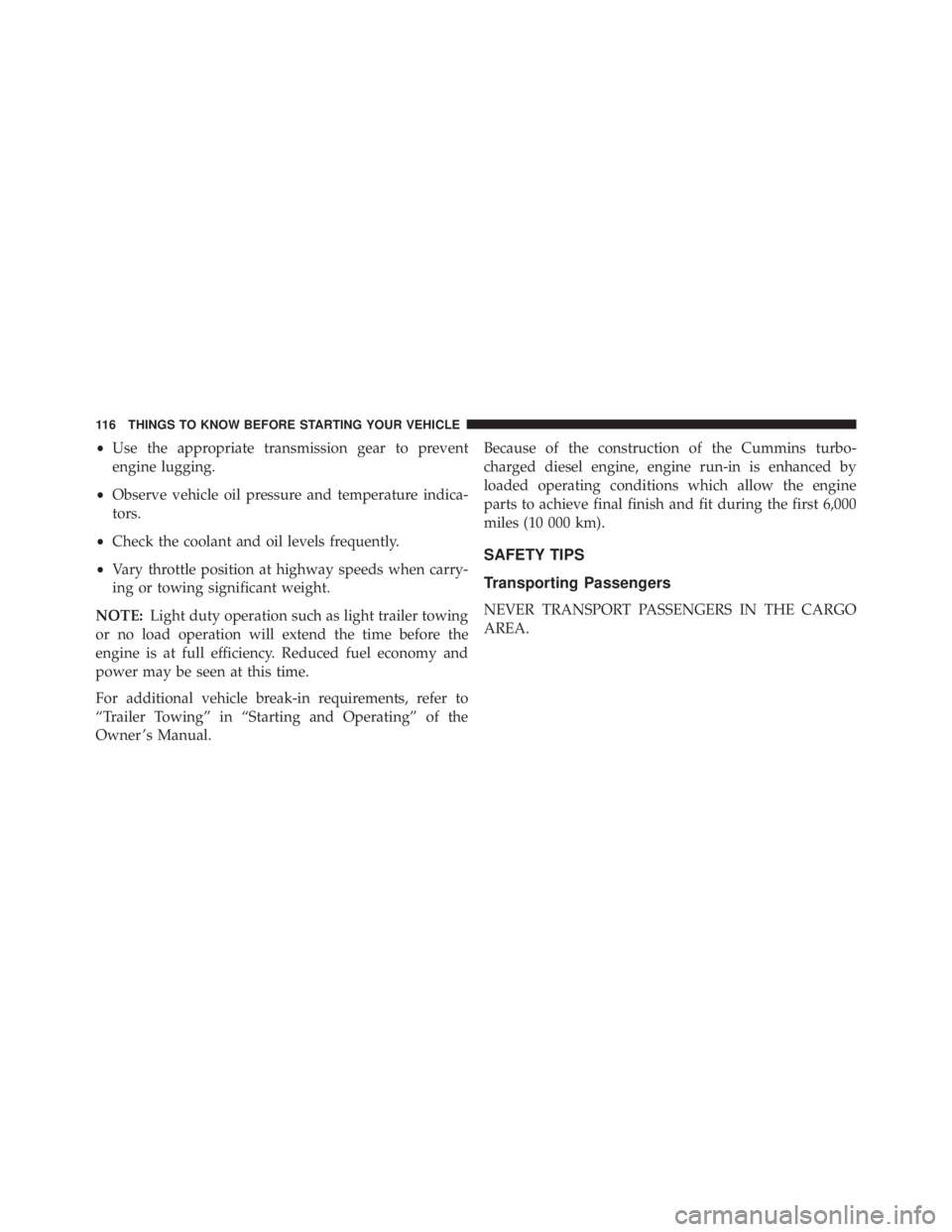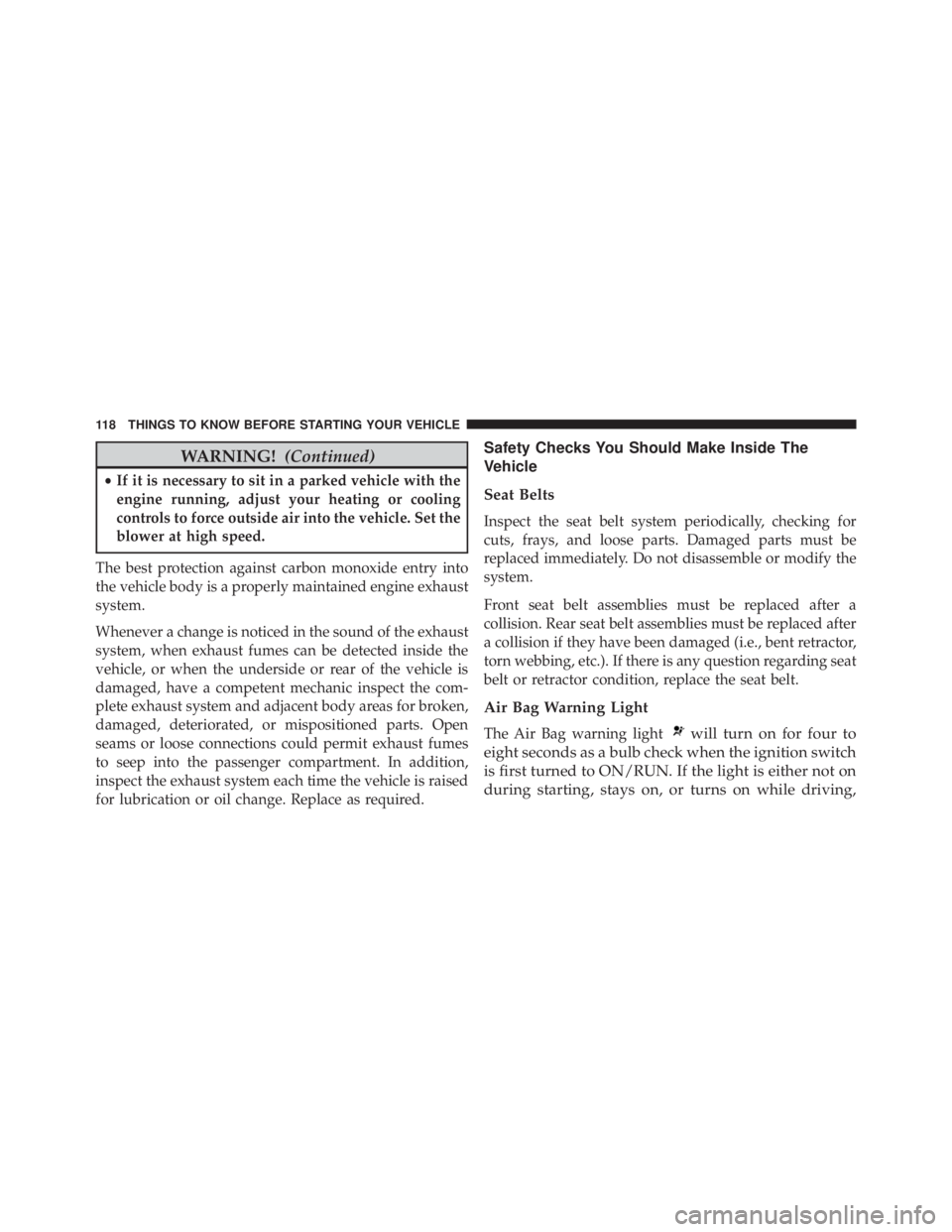RAM CHASSIS CAB 2016 Owners Manual
Manufacturer: RAM, Model Year: 2016, Model line: CHASSIS CAB, Model: RAM CHASSIS CAB 2016Pages: 675, PDF Size: 5.46 MB
Page 111 of 675

Crew Cab Trucks:
The top tether anchorages in this vehicle are tether strap
loops located between the rear glass and the back of the
rear seat. There is a tether strap loop located behind each
seating position. Follow the steps below to attach the
tether strap of the child restraint.
Right or Left Outboard Seats:
1. Raise the head restraint and reach between the rear
seat and rear glass to access the tether strap loop. Head Restraint In Raised Position 2THINGS TO KNOW BEFORE STARTING YOUR VEHICLE 109
Page 112 of 675

2. Place a child restraint on the seat and adjust the tether
strap so that it will reach over the seat back, under the
head restraint, through the tether strap loop behind
the seat and over to the tether strap loop behind the
center seat. 3. Pass the tether strap hook under the head restraint
behind the child seat, though the tether strap loop
behind the seat and over to the center tether strap
loop.
Tether Strap Loop With Center Head Restraint In Raised
Position
Tether Strap Through Outboard Tether Strap Loop110 THINGS TO KNOW BEFORE STARTING YOUR VEHICLE
Page 113 of 675

4. Attach the hook to the center tether strap loop (see
diagram). Tighten the tether strap according to the
child seat manufacturer ’s instructions. NOTE: If there are child seats in both of the outboard (left
and right) seating positions, the tether strap hooks of
both child seats should be connected to the center tether
strap loop. This is the correct way to tether two outboard
child seats.
Center Seat:
1. Raise the head restraint and reach between the rear
seat and rear glass to access the tether strap loop.
Tether Strap Through Outboard Tether Strap Loop And
Attached To Center Tether Strap Loop 2THINGS TO KNOW BEFORE STARTING YOUR VEHICLE 111
Page 114 of 675

2. Place a child restraint on the seat and adjust the tether
strap so that it will reach over the seat back, under the
head restraint, through the tether strap loop behind
the seat and over to the tether strap loop behind either
the right or left outboard seat. 3. Pass the tether strap hook under the head restraint
behind the child seat, though the tether strap loop
behind the seat and over to the right or left outboard
tether strap loop.
Tether Strap Loop With Head Restraint In Raised
Position
Tether Strap Through Center Tether Strap Loop112 THINGS TO KNOW BEFORE STARTING YOUR VEHICLE
Page 115 of 675

4. Attach the hook to the outboard tether strap loop (see
diagram). Tighten the tether strap according to the
child seat manufacturer ’s instructions. Installing Three Child Restraints:
1. Place a child restraint on each outboard rear seat.
Route the tether straps following the directions for
right and left seating positions, above.
2. Attach both hooks to the center tether strap loop, but
do not tighten the straps yet.
3. Place a child restraint on the center rear seat. Route the
tether strap following the directions for the center
seating position, above.
4. Attach the hook to the outboard tether strap loop.
5. Tighten the tether straps according to the child seat
manufacturer ’s instructions, tightening the right and
left tether straps before the center tether strap.Tether Strap Through Center Tether Strap Loop And
Attached To Outboard Tether Strap Loop 2THINGS TO KNOW BEFORE STARTING YOUR VEHICLE 113
Page 116 of 675

WARNING!• An incorrectly anchored tether strap could lead to
increased head motion and possible injury to the
child. Use only the anchorage position directly (Continued) WARNING! (Continued)behind the child seat to secure a child restraint top
tether strap.
• If your vehicle is equipped with a split rear seat,
make sure the tether strap does not slip into the
opening between the seatbacks as you remove
slack in the strap.
Transporting Pets
Air Bags deploying in the front seat could harm your pet.
An unrestrained pet will be thrown about and possibly
injured, or injure a passenger during panic braking or in
a collision.
Pets should be restrained in the rear seat in pet harnesses
or pet carriers that are secured by seat belts.Left Outboard And Center Seating Position Shown114 THINGS TO KNOW BEFORE STARTING YOUR VEHICLE
Page 117 of 675

ENGINE BREAK-IN RECOMMENDATIONS
A long break-in period is not required for the engine and
drivetrain (transmission and axle) in your vehicle.
Drive moderately during the first 300 miles (500 km).
After the initial 60 miles (100 km), speeds up to 50 or
55 mph (80 or 90 km/h) are desirable.
While cruising, brief full-throttle acceleration within the
limits of local traffic laws contributes to a good break-in.
Wide-open throttle acceleration in low gear can be detri-
mental and should be avoided.
The engine oil installed in the engine at the factory is a
high-quality energy conserving type lubricant. Oil
changes should be consistent with anticipated climate
conditions under which vehicle operations will occur. For
the recommended viscosity and quality grades, refer to
“Maintenance Procedures” in “Maintaining Your Ve-
hicle.” CAUTION!Never use Non-Detergent Oil or Straight Mineral Oil
in the engine or damage may result.
NOTE: A new engine may consume some oil during its
first few thousand miles (kilometers) of operation. This
should be considered a normal part of the break-in and
not interpreted as a problem.
Diesel Engine
The Cummins turbocharged diesel engine does not re-
quire a break-in period due to its construction. Normal
operation is allowed, providing the following recommen-
dations are followed:
• Warm up the engine before placing it under load.
• Do not operate the engine at idle for prolonged
periods. 2THINGS TO KNOW BEFORE STARTING YOUR VEHICLE 115
Page 118 of 675

• Use the appropriate transmission gear to prevent
engine lugging.
• Observe vehicle oil pressure and temperature indica-
tors.
• Check the coolant and oil levels frequently.
• Vary throttle position at highway speeds when carry-
ing or towing significant weight.
NOTE: Light duty operation such as light trailer towing
or no load operation will extend the time before the
engine is at full efficiency. Reduced fuel economy and
power may be seen at this time.
For additional vehicle break-in requirements, refer to
“Trailer Towing” in “Starting and Operating” of the
Owner ’s Manual. Because of the construction of the Cummins turbo-
charged diesel engine, engine run-in is enhanced by
loaded operating conditions which allow the engine
parts to achieve final finish and fit during the first 6,000
miles (10 000 km).
SAFETY TIPS
Transporting Passengers
NEVER TRANSPORT PASSENGERS IN THE CARGO
AREA.116 THINGS TO KNOW BEFORE STARTING YOUR VEHICLE
Page 119 of 675

WARNING!• Do not leave children or animals inside parked
vehicles in hot weather. Interior heat build-up may
cause serious injury or death.
• It is extremely dangerous to ride in a cargo area,
inside or outside of a vehicle. In a collision, people
riding in these areas are more likely to be seriously
injured or killed.
• Do not allow people to ride in any area of your
vehicle that is not equipped with seats and seat
belts.
• Be sure everyone in your vehicle is in a seat and
using a seat belt properly. Exhaust Gas
WARNING!Exhaust gases can injure or kill. They contain carbon
monoxide (CO), which is colorless and odorless.
Breathing it can make you unconscious and can
eventually poison you. To avoid breathing (CO),
follow these safety tips:
• Do not run the engine in a closed garage or in
confined areas any longer than needed to move
your vehicle in or out of the area.
• If you are required to drive with the trunk/liftgate/
rear doors open, make sure that all windows are
closed and the climate control BLOWER switch is
set at high speed. DO NOT use the recirculation
mode. (Continued) 2THINGS TO KNOW BEFORE STARTING YOUR VEHICLE 117
Page 120 of 675

WARNING! (Continued)• If it is necessary to sit in a parked vehicle with the
engine running, adjust your heating or cooling
controls to force outside air into the vehicle. Set the
blower at high speed.
The best protection against carbon monoxide entry into
the vehicle body is a properly maintained engine exhaust
system.
Whenever a change is noticed in the sound of the exhaust
system, when exhaust fumes can be detected inside the
vehicle, or when the underside or rear of the vehicle is
damaged, have a competent mechanic inspect the com-
plete exhaust system and adjacent body areas for broken,
damaged, deteriorated, or mispositioned parts. Open
seams or loose connections could permit exhaust fumes
to seep into the passenger compartment. In addition,
inspect the exhaust system each time the vehicle is raised
for lubrication or oil change. Replace as required. Safety Checks You Should Make Inside The
Vehicle
Seat Belts
Inspect the seat belt system periodically, checking for
cuts, frays, and loose parts. Damaged parts must be
replaced immediately. Do not disassemble or modify the
system.
Front seat belt assemblies must be replaced after a
collision. Rear seat belt assemblies must be replaced after
a collision if they have been damaged (i.e., bent retractor,
torn webbing, etc.). If there is any question regarding seat
belt or retractor condition, replace the seat belt.
Air Bag Warning Light
The Air Bag warning light will turn on for four to
eight seconds as a bulb check when the ignition switch
is first turned to ON/RUN. If the light is either not on
during starting, stays on, or turns on while driving,118 THINGS TO KNOW BEFORE STARTING YOUR VEHICLE